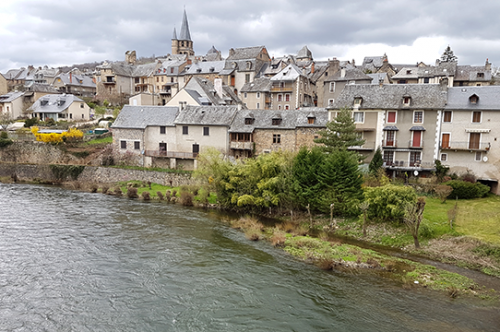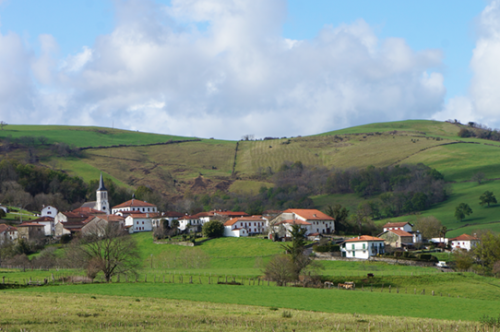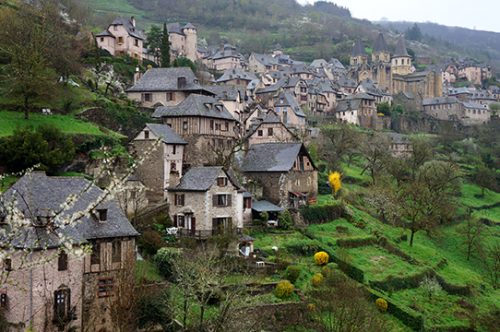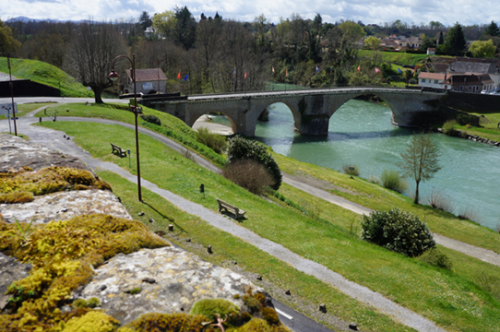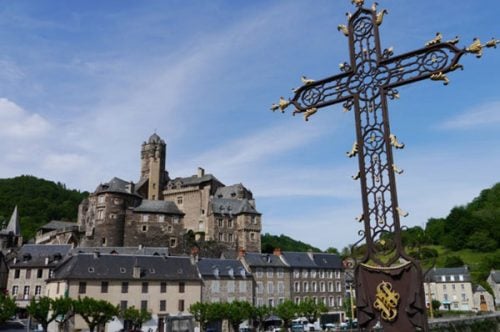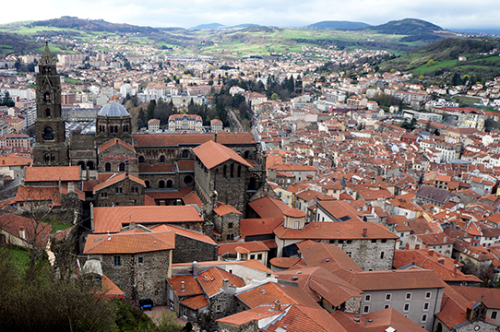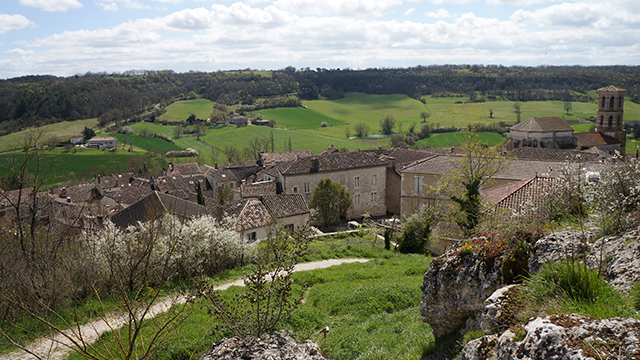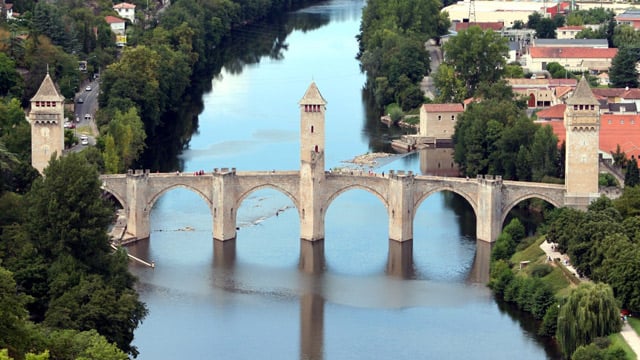Le Chemin du Puy
Le Chemin du Puy, also known as the Via Podiensis, is the most iconic of the Camino de Santiago routes in France. Beginning in the beautiful Le Puy-en-Velay, this 736 km pilgrimage trail crosses some of France’s most breathtaking landscapes before joining the Camino Francés at Saint-Jean-Pied-de-Port, in the foothills of the Pyrenees.
First recorded in the 12th-century Codex Calixtinus, Le Chemin du Puy is one of the four great French pilgrim routes that guided medieval travellers to Santiago de Compostela. Today, it continues to attract pilgrims from all over the world thanks to its cultural richness, natural beauty, and authentic French hospitality.
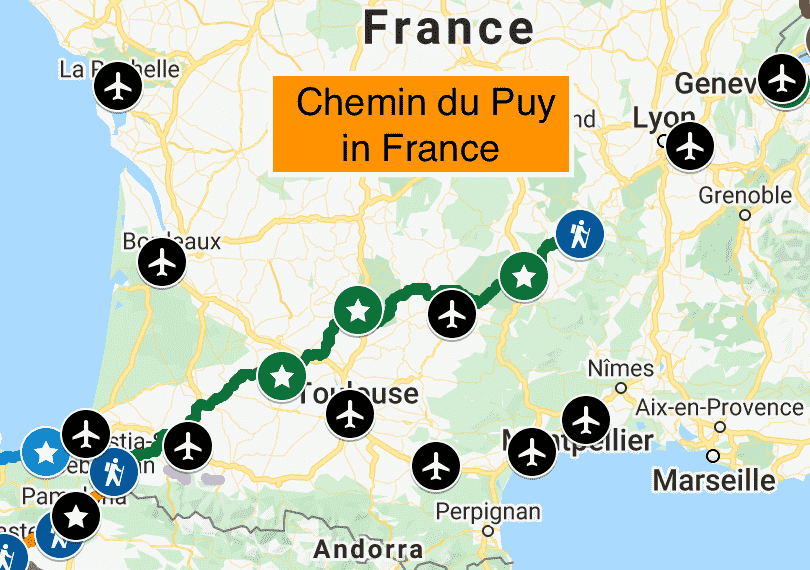
The route begins in the striking volcanic city of Le Puy-en-Velay, where highlights include the Saint-Michel d’Aiguilhe chapel, perched atop an 85-metre volcanic needle, and the Notre-Dame du Puy Cathedral, a UNESCO World Heritage Site. From there, the trail winds through velvety volcanic plateaus, the wild Aubrac region, and the medieval jewel of Conques, before meandering past the Armagnac vineyards and into the majestic Pyrenees Mountains.
Whether you choose to walk the full 4–5 weeks from Le Puy to Saint-Jean-Pied-de-Port or explore a shorter section such as Le Puy to Conques, this route offers an unforgettable journey through French history, spirituality, and gastronomy. Pilgrims are rewarded with magnificent views, warm welcomes, and the timeless rhythm of walking through rural France.
Why Walk Le Chemin du Puy?
Le Chemin du Puy is a Camino for the senses:
- Dramatic volcanic rock spires and mountain plateaus.
- Quiet villages and medieval towns like Conques and Cahors.
- Cathedrals, abbeys, chapels, and bridges steeped in pilgrim history.
- The flavours of French cuisine and Armagnac vineyards.
For many, this route is the perfect introduction to the Camino in France — long enough to feel like a true pilgrimage, but divided into beautiful, manageable stages.
Suggested Routes
Highlights of Le Chemin du Puy
- Le Puy-en-Velay – start at the striking Notre-Dame Cathedral and Saint Michel d’Aiguilhe chapel.
- The Aubrac Plateau – wild, windswept highlands.
- Conques – a medieval gem with its abbey of Sainte-Foy.
- Figeac & Cahors – historic towns rich in art, mosaics, and bridges.
- Armagnac vineyards – taste one of France’s finest brandies.
- Pyrenees Mountains – dramatic finale before joining the Camino Francés.
👉 Thinking of a shorter journey? Many pilgrims walk just Le Puy to Conques (200 km) for a one-week cultural Camino.
Suggested Routes
- Full Chemin du Puy – Le Puy to Saint-Jean (736 km, 4–5 weeks).
- Le Puy to Conques – (202 km, 10 days) volcanic landscapes & Conques abbey.
- Conques to Cahors – (137 km, 1 week).
- Customise your route with our Camino Planner.
When to Go
- April to October – best balance of weather & services.
- Summer – hot in the south, busy in tourist towns.
- Winter/early spring – snow in Aubrac and the Pyrenees, fewer open hotels.
👉 See more in our Best Time to Walk the Camino guide.
Camino Ways Route Planner
For over 1000 years, pilgrims from all over the world have walked the Camino Ways across Europe in their quest for spirituality. Making the pilgrimage to Santiago de Compostela in Spain, they encountered a variety of people, cultures and beliefs, leading to friendship and new experiences. This continues today with the Camino de Santiago being the most well known and well-loved walk in the world. More than just a walk, the Camino de Santiago is an unforgettable and unique journey for the body, mind and soul.
Terrain
- Varied: volcanic rock, rolling pastures, vineyards, wooded valleys, and high mountain paths.
- Expect steep ascents to Aubrac and the Pyrenees, but well-marked trails (red & white stripes).
- Daily ascents/descents: 300–600 m.
👉 Prepare with our Camino Fitness Plan.
What To Bring On Le Chemin Du Puy?
Our Camino packing guide ebook is free to download. This will help you decide what to bring on your Camino.
History of Le Chemin du Puy
The magical Chemin du Puy full route is one of the main Camino trails through France that lead all the way to Santiago de Compostela. Traditionally this way would have been used by French pilgrims and those travelling from Germany and Switzerland.
The Bishop of Le Puy, Godescalc, is said to be one of the first pilgrims to walk from Le Puy in 951 AD. Nowadays, this route is popular for its many charming towns, undulating hills and typical French cuisine.
The Le Puy Camino was mentioned by Aymeric Picaud in the Camino’s first-ever ‘guidebook’, the 12th-century Codex Calixtinus. One of the most high-profile medieval pilgrims walking to Santiago was Godescalc, Bishop of Le Puy. He went on pilgrimage to Santiago in the 10th century and is said to have inspired many other French pilgrims to do the same.
👉 Learn more in our History of the Camino de Santiago.
Camino Made Easy
With CaminoWays, your journey includes:
- Handpicked hotels & guesthouses.
- Daily luggage transfers so you walk light.
- 24/7 support, maps & walking notes.
👉 See also: Guided Tours or Self-Guided Tours.
FAQs
Q: What is Le Chemin du Puy?
A: Le Chemin du Puy, or Via Podiensis, is the most popular Camino de Santiago route in France. It starts in Le Puy-en-Velay and joins the Camino Francés at Saint-Jean-Pied-de-Port.
Q: How long is Le Chemin du Puy?
A: The route is about 736 km and takes 4–5 weeks to walk. Many pilgrims choose to walk shorter sections, such as Le Puy to Conques.
Q: What are the highlights of Le Chemin du Puy?
A: Highlights include Le Puy-en-Velay’s cathedral, the volcanic landscapes of the Velay, the Aubrac plateau, Conques, Cahors, the Armagnac vineyards, and the Pyrenees.
Q: When is the best time to walk Le Chemin du Puy?
A: April to October is recommended. Winter brings snow to Aubrac and the Pyrenees, while summer can be hot in parts of southern France. See our guide to the best time to walk the Camino.
Q: Does Le Chemin du Puy connect to other Camino routes?
A: Yes, it links directly with the Camino Francés at Saint-Jean-Pied-de-Port, allowing pilgrims to continue all the way to Santiago de Compostela.
Q: What should I pack for Le Chemin du Puy?
A: Essentials include layered clothing, sturdy footwear, and rain protection. Download our free Camino packing list for full details.
Le Chemin du Puy Route Description
The Chemin du Puy route passes some of the most beautiful villages in France until it reaches its final point in Saint Jean Pied de Port. There, the most dedicated pilgrims can continue their way to Santiago de Compostela along the famous French Way.
You will be pleasantly surprised by the scenery along this route. This is a beautiful way of walking one of the four main pilgrimage routes through France. The route is well marked with red and white stripes painted on tree trunks, stone walls and even houses along the route.
Some of the mountain ranges along this way are steep but you will find beautiful resting points in historic villages and towns.
Your starting town for this Camino walk is Le-Puy-en-Velay, which has some stunning highlights like the famous 12th century Notre Dame Cathedral at the top of an 85-metre high volcanic rock overlooking the city.
After leaving Le Puy, the route is a superb rural hike through the Aubrac plateau, Quercy, Gers (home to the famous Armagnac brandy), and the majestic Pyrenees Mountains.
Once finished le Chemin du Puy, the most motivated pilgrims continue their way to Santiago de Compostela on the Camino Frances, starting their journey in Saint-Jean-Pied-de-Port.
Closing Thought
Le Chemin du Puy is often called the quintessential French Camino. With its mix of nature, heritage, and gastronomy, it’s a pilgrimage for both the spirit and the senses — and the perfect starting point for continuing all the way to Santiago.
👉 If you’d like a personalised Le Chemin du Puy itinerary, try our Award Winning Camino Planner.
